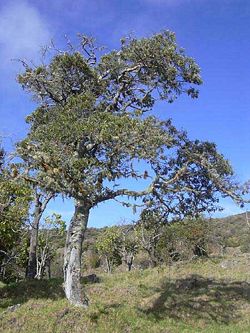Rhamnaceae: Difference between revisions
order correction |
-cat |
||
| Line 83: | Line 83: | ||
[[Category:Plant families]] |
[[Category:Plant families]] |
||
[[Category:Rosales]] |
|||
[[da:Korsved-familien]] |
[[da:Korsved-familien]] |
||
Revision as of 09:08, 25 May 2006
| Buckthorn family | |
|---|---|

| |
| Hawaii kauilatree (Alphitonia ponderosa) | |
| Scientific classification | |
| Kingdom: | |
| Division: | |
| Class: | |
| Order: | |
| Family: | Rhamnaceae |
| Genera | |
|
See text. | |
Rhamnaceae, the Buckthorn family, is a large family of flowering plants, mostly trees, shrubs and some vines.
The family contains 50-55 genera and approximately 870-900 species. The Rhamnaceae have a worldwide distribution, but are more common in the subtropical and tropical regions. The earliest fossil evidence of Rhamnaceae is from the Eocene.
The simple leaves can be either alternate and spiraling, or opposite. Stipules are present. These leaves are modified into spines in many genera, in some (e.g. Paliurus spina-christi and Colletia cruciata) spectacularly so. Colletia stands out by having two axillary buds instead of one, one developing into a thorn, the other one into a shoot.
The flowers are radially symmetrical. There are 5 (sometimes 4) separate sepals and 5 (sometimes 4 or none) separate petals. The petals may be white, yellowish, greenish, pink or blue, and are small and inconspicuous in most genera, though in some (e.g. Ceanothus) the dense clusters of flowers are conspicuous. The 5 or 4 stamens are isomerous with the petals (i.e. one stamen opposite each petal). The ovary is superior, with 2 or 3 ovules (or one by abortion)
The fruits are mostly berries, fleshy drupes or nuts. Some are adapted to wind carriage, but most are dispersed by mammals and birds. Chinese jujube is the fruit of the jujube tree (Ziziphus zizyphus) and is a major fruit in China.
The American genus Ceanothus, which has several showy ornamental species, has nitrogen-fixing root nodules.
Economic uses of the Rhamnaceae are chiefly as ornamental plants and as the source of many brilliant green and yellow dyes. The wood of Rhamnus was also the most favoured species to make charcoal for use in gunpowder before the development of modern propellants.
Genera
- Adolphia
- Alphitonia
- Alvimiantha
- Ampelozizyphus
- Auerodendron
- Bathiorhamnus
- Berchemia
- Berchemiella
- Blackallia
- Ceanothus
- Chaydaia
- Colletia
- Colubrina
- Condalia
- Crumenaria
- Cryptandra
- Discaria
- Doerpfeldia
- Emmenosperma
- Frangula
- Gouania
- Helinus
- Hovenia
- Karwinskia
- Kentrothamnus
- Krugiodendron
- Lasiodiscus
- Maesopsis
- Nesiota
- Noltea
- Paliurus: Christs thorn
- Phylica
- Pomaderris
- Reissekia
- Retanilla
- Reynosia
- Rhamnella
- Rhamnus: Buckthorn
- Sageretia
- Schistocarpaea
- Scutia
- Siegfriedia
- Smythea
- Spyridium
- Talguenea
- Trevoa
- Trymalium
- Ventilago
- Ziziphus: Jujube
